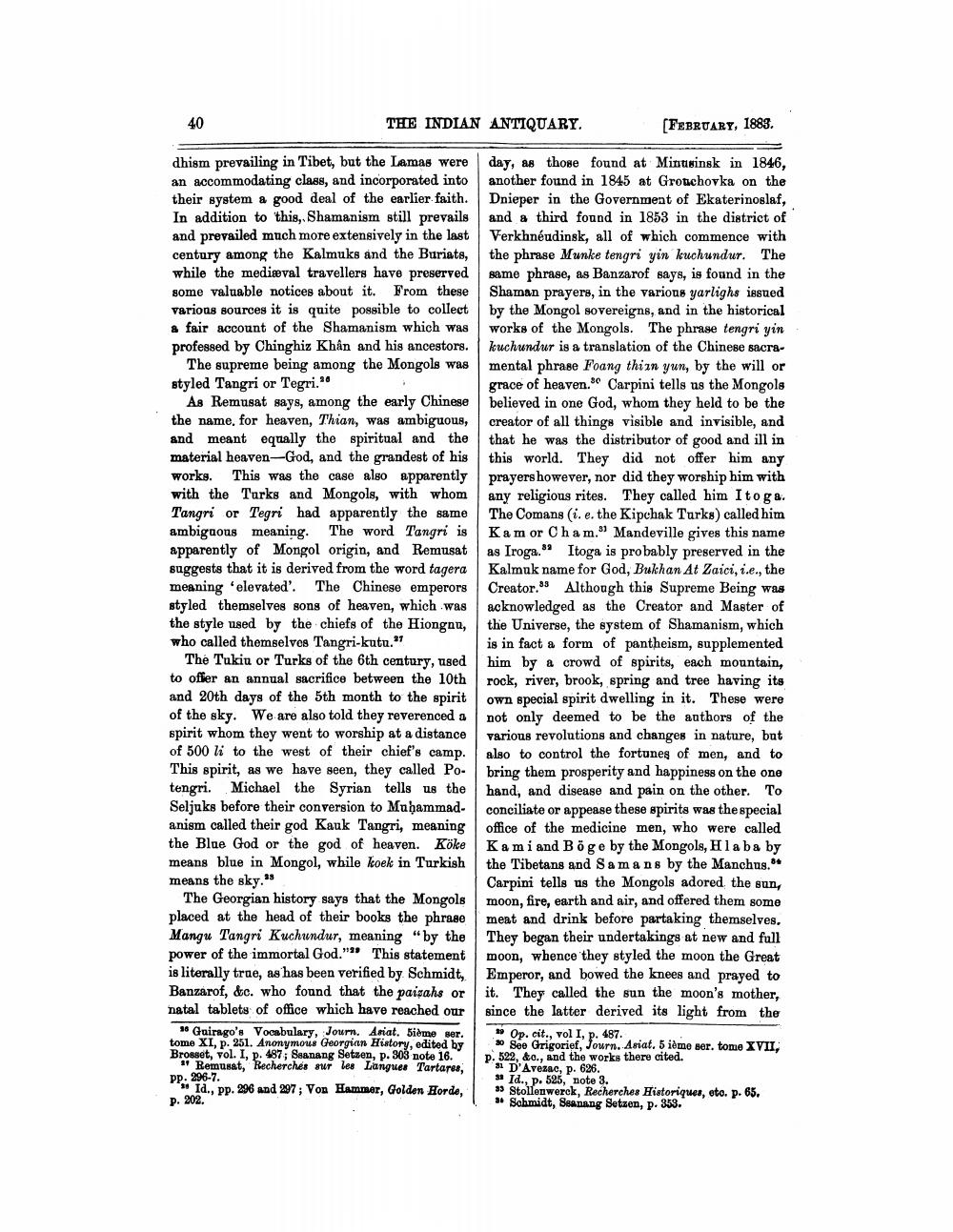________________
40
THE INDIAN ANTIQUARY.
(FEBRUARY, 1883.
dhism prevailing in Tibet, but the Lamas were day, as those found at Mintisinsk in 1846, an accommodating class, and incorporated into another found in 1845 at Grotichovka on the their system a good deal of the earlier faith. Dnieper in the Government of Ekaterinoslaf, In addition to this, Shamanism still prevails and a third found in 1853 in the district of and prevailed much more extensively in the last Verkhnéudinsk, all of which commence with century among the Kalmuks and the Buriats, the phrase Munke tengri yin kuchundur. The while the medieval travellers have preserved same phrase, as Banzarof says, is found in the some valuable notices about it. From these Shaman prayers, in the various yarlighs issued various sources it is quite possible to collect by the Mongol sovereigns, and in the historical a fair account of the Shamanism which was works of the Mongols. The phrase tengri yin professed by Chinghiz Khan and his ancestors. kuchundur is a translation of the Chinese sacra
The supreme being among the Mongols was mental phrase Foang thiın yun, by the will or styled Tangri or Tegri."
grace of heaven. Carpini tells us the Mongols As Remusat says, among the early Chinese believed in one God, whom they held to be the the name, for heaven, Thian, was ambiguous, creator of all things visible and invisible, and and meant equally the spiritual and the that he was the distributor of good and ill in material heaven-God, and the grandest of his this world. They did not offer him any works. This was the case also apparently | prayers however, nor did they worship him with with the Turks and Mongols, with whom any religious rites. They called him Itoga. Tangri or Tegri had apparently the same The Comans (i.e. the Kipchak Turks) called him ambiguous meaning. The word Tangri is Kamor Cham." Mandeville gives this name apparently of Mongol origin, and Remusat as Iroga." Itoga is probably preserved in the suggests that it is derived from the word tagera Kalmuk name for God, Bukhan At Zaici, i.e., the meaning "elevated'. The Chinese emperors Creator. Although this Supreme Being was styled themselves song of heaven, which was acknowledged as the Creator and Master of the style used by the chiefs of the Hiongau, the Universe, the system of Shamanism, which who called themselves Tangri-kutu."
is in fact a form of pantheism, supplemented The Tukiu or Turks of the 6th century, used him by a crowd of spirits, each mountain, to offer an annual sacrifice between the 10th rock, river, brook, spring and tree having its and 20th days of the 5th month to the spirit own special spirit dwelling in it. These were of the sky. We are also told they reverenced a not only deemed to be the authors of the spirit whom they went to worship at a distance various revolutions and changes in nature, but of 500 li to the west of their chief's camp. also to control the fortunes of men, and to This spirit, as we have seen, they called Po bring them prosperity and happiness on the one tengri. Michael the Syrian tells us the hand, and disease and pain on the other. To Seljuks before their conversion to Muhammad conciliate or appease these spirits was the special anism called their god Kauk Tangri, meaning office of the medicine men, who were called the Blue God or the god of heaven. Köke Kami and Boge by the Mongols, H laba by means blue in Mongol, while koek in Turkish the Tibetans and Samans by the Manchus.** means the sky."
Carpini tells us the Mongols adored the sun, The Georgian history says that the Mongols moon, fire, earth and air, and offered them some placed at the head of their books the phrase meat and drink before partaking themselves. Mangu Tangri Kuchundur, meaning "by the They began their undertakings at new and full power of the immortal God." This statement moon, whence they styled the moon the Great is literally trae, as has been verified by Schmidt, Emperor, and bowed the knees and prayed to Banzarof, &c. who found that the paisahs or it. They called the sun the moon's mother, natal tablets of office which have reached our since the latter derived its light from the
90 Guirago's Vocabulary, Journ. Asiat. Sième ser. Op. cit., vol I, p. 487. tome XI, p. 251. Anonymous Georgian History, edited by 30 See Grigorief, Journ. Asiat. 5 ième ser. tome XVII, Brosset, vol. I, p. 487, Seanang Setzen, p. 303 note 16. P. 522, &c., and the works there cited.
"Remusat, Recherches sur les Langues Tartares, 31 D'Avezac, p. 626. pp. 296-7.
Id., p. 525, note 3. ** Id., pp. 206 and 297; Von Hammer, Golden Horde, Stollenwerck, Recherches Historiques, eto. p. 65. p. 202.
Sohmidt, Seanang Setzen, p. 353.




